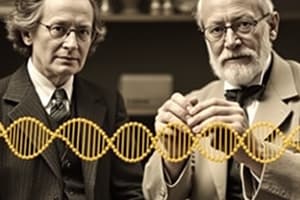Podcast
Questions and Answers
What is the role of the primer in DNA synthesis during sequencing reaction?
What is the role of the primer in DNA synthesis during sequencing reaction?
- It terminates DNA synthesis
- It provides the initial 3'OH group (correct)
- It provides the ddNTPs
- It is not involved in DNA synthesis
What is the main difference between dNTPs and ddNTPs?
What is the main difference between dNTPs and ddNTPs?
- ddNTPs are longer than dNTPs
- ddNTPs lack 3'OH groups (correct)
- ddNTPs are more reactive than dNTPs
- ddNTPs are more stable than dNTPs
What is the function of ddNTPs in DNA sequencing reaction?
What is the function of ddNTPs in DNA sequencing reaction?
- They provide the initial 3'OH group
- They support termination of DNA synthesis (correct)
- They enhance DNA synthesis
- They prevent DNA synthesis from occurring
How is termination of DNA synthesis base selective during sequencing reaction?
How is termination of DNA synthesis base selective during sequencing reaction?
What happens if a ddNTP is incorporated into the growing DNA strand during sequencing reaction?
What happens if a ddNTP is incorporated into the growing DNA strand during sequencing reaction?
What is the source of the subsequent 3'OH group needed for DNA synthesis during sequencing reaction?
What is the source of the subsequent 3'OH group needed for DNA synthesis during sequencing reaction?
What is the role of the dyes attached to ddNTPs during sequencing reaction?
What is the role of the dyes attached to ddNTPs during sequencing reaction?
What happens if a dNTP is incorporated into the growing DNA strand during sequencing reaction?
What happens if a dNTP is incorporated into the growing DNA strand during sequencing reaction?
Flashcards
Primer
Primer
A short, single-stranded piece of DNA that initiates DNA synthesis.
ddNTPs
ddNTPs
Special nucleotides that lack a 3' hydroxyl group.
DNA sequencing
DNA sequencing
A process of determining the exact sequence of nucleotides in a DNA molecule.
How do ddNTPs work in sequencing?
How do ddNTPs work in sequencing?
Signup and view all the flashcards
What does the incorporated dNTP provide?
What does the incorporated dNTP provide?
Signup and view all the flashcards
What's the role of dyes attached to ddNTPs?
What's the role of dyes attached to ddNTPs?
Signup and view all the flashcards
What happens when a dNTP is added?
What happens when a dNTP is added?
Signup and view all the flashcards
Why does ddNTP incorporation stop DNA synthesis?
Why does ddNTP incorporation stop DNA synthesis?
Signup and view all the flashcards
Study Notes
DNA Synthesis and Sequencing Reaction
- The primer plays a crucial role in DNA synthesis during sequencing reaction by providing a starting point for DNA polymerase to synthesize new DNA strands.
dNTPs vs ddNTPs
- The main difference between dNTPs (deoxyribonucleoside triphosphates) and ddNTPs (dideoxyribonucleoside triphosphates) is that dNTPs have a 3' hydroxyl (-OH) group, while ddNTPs have a 3' hydrogen (H) instead, which prevents further DNA synthesis.
ddNTPs in DNA Sequencing Reaction
- The function of ddNTPs in DNA sequencing reaction is to terminate DNA synthesis by incorporating themselves into the growing DNA strand, making them ideal for Sanger sequencing.
Termination of DNA Synthesis
- Termination of DNA synthesis is base selective during sequencing reaction because each ddNTP is labeled with a different fluorescent dye, allowing for the identification of the incorporated nucleotide.
Incorporation of ddNTPs and dNTPs
- If a ddNTP is incorporated into the growing DNA strand during sequencing reaction, DNA synthesis terminates because the 3' end of the strand cannot be extended further.
- If a dNTP is incorporated into the growing DNA strand during sequencing reaction, DNA synthesis continues because the 3' hydroxyl (-OH) group allows for further extension.
Source of 3'OH Group
- The subsequent 3'OH group needed for DNA synthesis during sequencing reaction is provided by the incorporated dNTPs.
Role of Dyes Attached to ddNTPs
- The role of the dyes attached to ddNTPs during sequencing reaction is to label the terminating nucleotides, allowing for the identification of the incorporated nucleotide during Sanger sequencing.
Studying That Suits You
Use AI to generate personalized quizzes and flashcards to suit your learning preferences.





